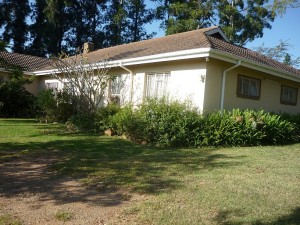It’s been one week since we left home. Today is a holiday here and I have the day off after Wednesday morning staff meeting. We did some shopping at the Pick N Pay supermarket while we were in town, but nearly all other stores are closed.
We are finding communication fairly time consuming. The internet connection to TWR is very slow. Just to check our email, it takes a couple minutes for the login page to load. After putting in our login information, it takes several minutes (this morning it took 10 minutes) to connect to the email site, then another two minutes to show the email that had come in. Our co-workers in the U.S. think the DSL that we use at home is slow — it works like lightning compared to this!
Connecting to Facebook usually takes a long time, so we use it a lot less than back home. It looks like email will be our primary method of communication.
We can use Skype and it seems to connect more quickly than doing email. If you want to contact us using your Skype connection, send us an email with your Skype address and we can provide our Skype information. The ‘call’ is free if you have a Skype account. We are typically on Skype from noon to 3pm Indiana time (CDT).
If you do not have a Skype account and would like for us to call you, send an email with the phone number and we can call your phone directly for less than 2 cents per minute. If you have a time that you would prefer a call, let us know. Just remember that we try to sleep from about 3pm t0 midnight Indiana time (CDT).
My time here is mostly spent at the transmitter site — two days so far. Initially I have been catching up on changes that have taken place since we were here a little over four years ago and trying to determine the current status of the transmitters. So far, I found out that the drive control on one of the three transmitters was performing quite differently than the other two. Yesterday, we determined that it had an old version of EPROMS on the CPU card. These were changed out for the newer version. Both spare CPU cards now have the old version.
We are beginning to get into the routine of things here. Before going to bed, there is a ‘ritual’ of locking security gates (there are four — two to the outside, one to the attached garage and one in the hallway between the main house and bedrooms) and certain doors. Then after we are securely in our bedroom, we activate the alarm, if it has not already activated itself at 10pm. We can move between the bedrooms and bathrooms without setting off the alarms. First thing in the morning, we deactivate the alarm and switch on the hot water heater for about 30 minutes so we can have warm showers.
When a co-worker and his family visited two nights ago we discovered that the alarm also activates some outside motion sensors. Our visitors had to explain to us what the intermittent squawking sound was. We assume that it automatically activates around dusk.

The front of our ‘home away from home’ in Swaziland. If you look closely you can see the security bars on the windows. The dark rectangular shape on the roof is an experimental solar heater for the geyser (hot water heater) made from black plastic pipe.
When we leave the house there is a similar routine of locking doors and gates. We have a remote device that we take with us, which has four buttons on it. One button is to open and close the garage door, the second button sets the alarm (there are bright LED lights in two of the house windows to indicate the alarm status), the third button opens the fence gate to drive out (it closes automatically once the car passes through) and one is a ‘panic’ button — pushing that one results in alerting TWR staff and a rapid response team from the security company. Of course the car has its own start-up sequence using its own remote button, plus hidden switch inside, which Virginia mentioned in her previous post. There is a similar reverse routine to return to the house.
Should the alarm sound while we are gone, it will call our cell phone as well as the cell phones of two other staff members. I think the security company is also alerted.
Many of the gates for vehicles are automatic and controlled with remote buttons carried in the vehicles. In addition, many of the gates can be opened by a call to a cell phone incorporated within that gate’s controls. The gate’s cell phone determines whether a valid number is calling before opening the gate. Since the gate phone never actually ‘answers’, there is no fee charged to either phone. If someone arrives at the gate off the main road which is about five miles from the site, that person can call the site, or other person with a valid phone, who can then open the gate by calling that gate’s cell phone number. If I should forget my remote gate opener, I can pull out my cell phone and call the gate’s cell phone number myself and not incur a fee to do so. If I forget both the remote and cell phone, it would be a long walk to the site or a long drive back home!

